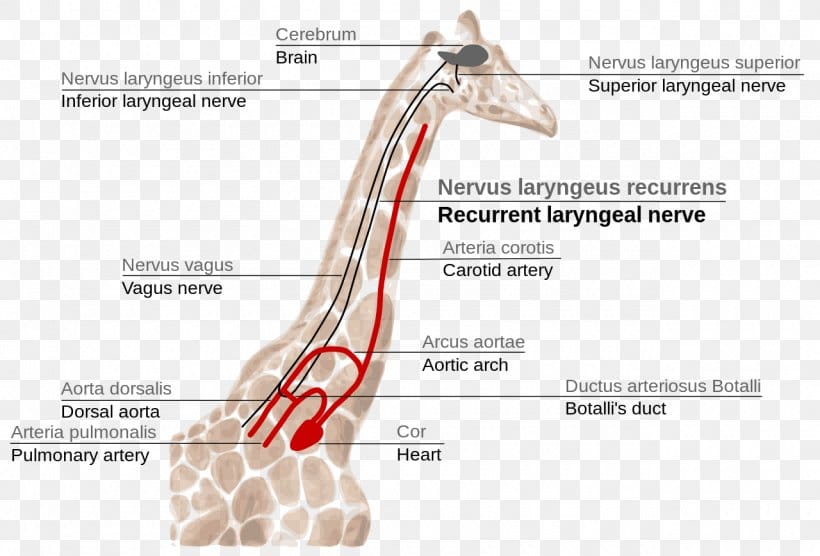The RLN in Giraffes: Adventures in Evolution

The recurrent laryngeal nerve (RLN), dear reader, is a curious feature found in mammals, and by "curious," I mean profoundly, head-scratchingly absurd. This nerve, whose job is to control the muscles of the larynx (or "voice box" for those less inclined toward fancy biology terms), has one simple task: help you breathe and, equally importantly, complain about traffic. In giraffes, however, the RLN takes a journey so unbelievably convoluted that it seems evolution was playing a practical joke. Instead of taking a direct route—because that would be logical—the nerve embarks on a cross-country road trip down the giraffe's neck, loops around the aorta near the heart (perhaps to stop for snacks), and then meanders all the way back up to the larynx. You might think this is a design flaw. You’d be right. But evolution, much like assembling furniture without instructions, often produces results that work, just not elegantly.
Anatomical Overview and Function of the RLN
The RLN begins its odyssey branching from the vagus nerve in the chest—a perfectly reasonable starting point if you're into needlessly complicated travel routes. In most mammals, the nerve’s journey is relatively short, like a quick drive across town. But in giraffes, whose necks stretch like an overly ambitious retractable leash, the nerve extends up to 15 feet. Imagine calling your friend upstairs, only to realize the call is routed through a phone tower in another state before reaching them. That’s the RLN in a giraffe. Despite this roundabout route, the nerve performs its crucial job of helping giraffes bellow, hum, or make whatever sounds giraffes make when they want to sound impressive.
Evolutionary Explanation: Tracing Ancestral Roots
Step 1: Fish Ancestors (When Life Was Simpler)
Long ago, in a world dominated by fish (and zero necks), the RLN connected the brain directly to the gills. Straightforward. Simple. No unnecessary detours. Life was easy. But then evolution, with its boundless creativity, decided, "Hey, what if some of these fish grew legs and walked on land?" And thus, things got complicated.
Step 2: The Neck Appears (Because Why Not?)
As animals evolved to explore land, necks emerged—useful for nodding and checking if it’s safe to cross the road. Meanwhile, the heart and arteries decided to migrate downward. The RLN, apparently a creature of habit, continued looping around the aorta, refusing to take the shortcut. Evolution, you see, doesn’t believe in starting from scratch; it’s more of a “stick with what you’ve got and tweak it” kind of process.
Step 3: Enter the Giraffe (Evolution’s Stretch Goal)
Fast forward to the giraffe, an animal whose neck seems like evolution got a bit carried away. The RLN’s journey now rivals a cross-country road trip from New York to Los Angeles—via Miami. It loops around the aorta near the heart and then heads back up the neck, which is both fascinating and absurd. The nerve isn’t inefficient by choice; it’s just stuck with a layout that’s been millions of years in the making.
Why Evolution Provides the Best Explanation
Surely no designer aiming for efficiency would route a nerve like this, right? Correct. This convoluted pathway makes sense only through the lens of evolution, which builds on what’s already there rather than starting fresh. The RLN’s journey is a perfect example of evolutionary tinkering: it works, so nature never bothered to fix the inefficiency. Evolution is less like a skilled architect and more like someone duct-taping together whatever parts are lying around—yet somehow, it holds up.

Philosophical and Scientific Significance
The giraffe’s RLN isn’t just an anatomical quirk—it’s a masterclass in how evolution operates through repurposing old structures. It’s less of a “grand design” and more of a “this’ll do” solution. Evolution isn’t about perfection; it’s about survival and functionality. The nerve’s elaborate detour highlights the principle that what works often sticks around, no matter how bizarre the outcome.
Conclusion
The recurrent laryngeal nerve in giraffes is evolution’s equivalent of taking the scenic route—unnecessarily long, slightly ridiculous, but ultimately functional. It’s a testament to nature’s improvisational skills, showing how evolutionary history shapes anatomy in ways that are sometimes laughably inefficient. Next time you see a giraffe, take a moment to appreciate that, tucked within its elegant neck, is a nerve with a journey so hilariously roundabout that it might just be nature’s way of reminding us that “good enough” is sometimes all you need.
Works Cited
Harrison, D. F. N. The Anatomy and Physiology of the Mammalian Larynx. Cambridge University Press, 1995.
Wedel, Mathew J. "A Monument of Inefficiency: The Presumed Course of the Recurrent Laryngeal Nerve in Sauropod Dinosaurs." Acta Palaeontologica Polonica, vol. 57, no. 2, 2011, pp. 251–256.


Comments ()